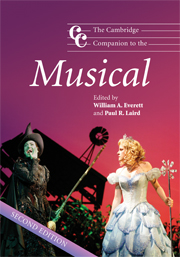Book contents
- Frontmatter
- Part I Adaptations and transformations: before 1940
- 1 American musical theatre before the twentieth century
- 2 Non-English-language musical theatre in the United States
- 3 Birth pangs, growing pains and sibling rivalry: musical theatre in New York, 1900–1920
- 4 American and British operetta in the 1920s: romance, nostalgia and adventure
- 5 Images of African Americans: African-American musical theatre, Show Boat and Porgy and Bess
- 6 The melody (and the words) linger on: American musical comedies of the 1920s and 1930s
- Part II Maturations and formulations: 1940–1970
- Part III Evolutions and integrations: after 1970
- Part IV Legacies and transformations
- Notes
- Select bibliography
- Index
4 - American and British operetta in the 1920s: romance, nostalgia and adventure
from Part I - Adaptations and transformations: before 1940
Published online by Cambridge University Press: 28 September 2011
- Frontmatter
- Part I Adaptations and transformations: before 1940
- 1 American musical theatre before the twentieth century
- 2 Non-English-language musical theatre in the United States
- 3 Birth pangs, growing pains and sibling rivalry: musical theatre in New York, 1900–1920
- 4 American and British operetta in the 1920s: romance, nostalgia and adventure
- 5 Images of African Americans: African-American musical theatre, Show Boat and Porgy and Bess
- 6 The melody (and the words) linger on: American musical comedies of the 1920s and 1930s
- Part II Maturations and formulations: 1940–1970
- Part III Evolutions and integrations: after 1970
- Part IV Legacies and transformations
- Notes
- Select bibliography
- Index
Summary
Operettas from the 1920s, the titles, music and lyrics of which evoke romantic images of times and places far away, enjoy a continued popularity that stems directly from their very nature of being ‘old-fashioned’. Shows such as The Student Prince, Rose Marie and Bitter Sweet are as nostalgic in the early twenty-first century as they were at the time of their creation. Their inherent sense of sentiment and escapism, deeply rooted in romantic innocence, has been both their ultimate blessing and paramount curse. But many of these works, including The Desert Song, The Three Musketeers and The New Moon, are also filled with adventure and swashbuckling heroes who achieve victory over some sort of political tyranny or oppression while still managing to find time to fall in love.
In nineteenth- and early twentieth-century Vienna, operetta was envisaged as a popular form of entertainment set in some sort of fictionalised Ruritania – a Central European (usually Balkan) domain with nobles and peasants suspended in an eternal nineteenth century. Even the name ‘Ruritania’, the setting of Anthony Hope's 1894 novel The Prisoner of Zenda, evokes a sense of familiar exoticism. Audiences adored such entertainments with plots in which characters interacted with each other in humorous and amorous ways while dressed in fanciful costumes amidst lavish sets. The action took place against a glorious musical score replete with waltzes, marches and tour-de-force solos and duets.
- Type
- Chapter
- Information
- The Cambridge Companion to the Musical , pp. 72 - 88Publisher: Cambridge University PressPrint publication year: 2008



